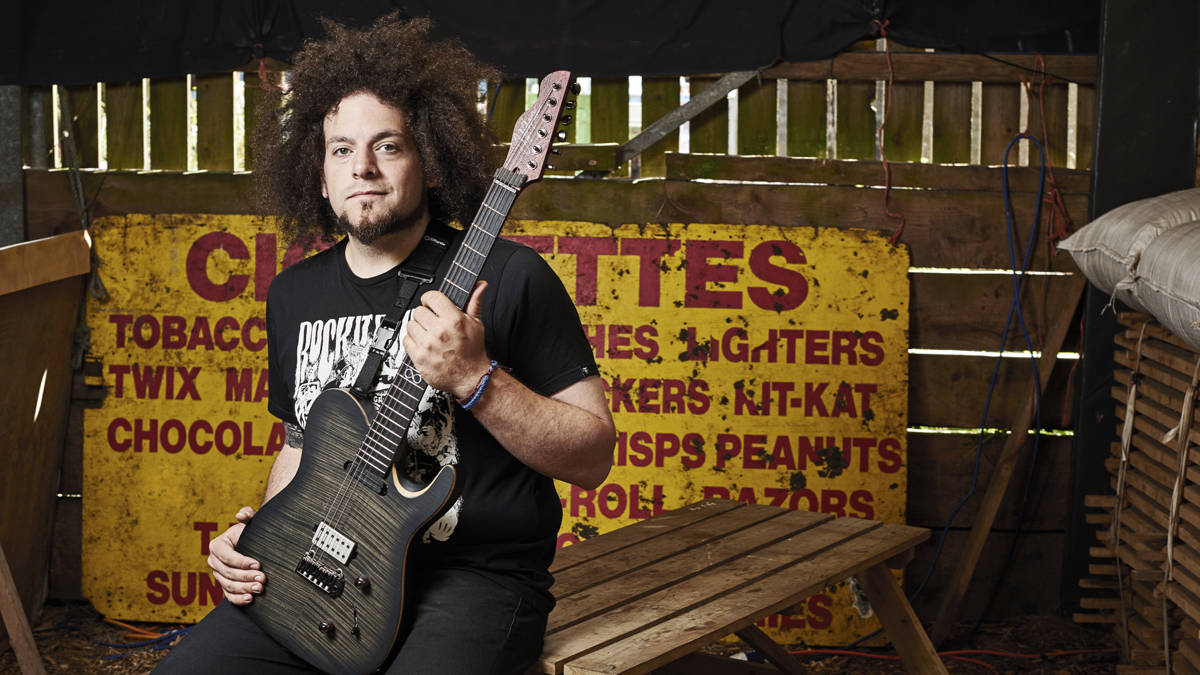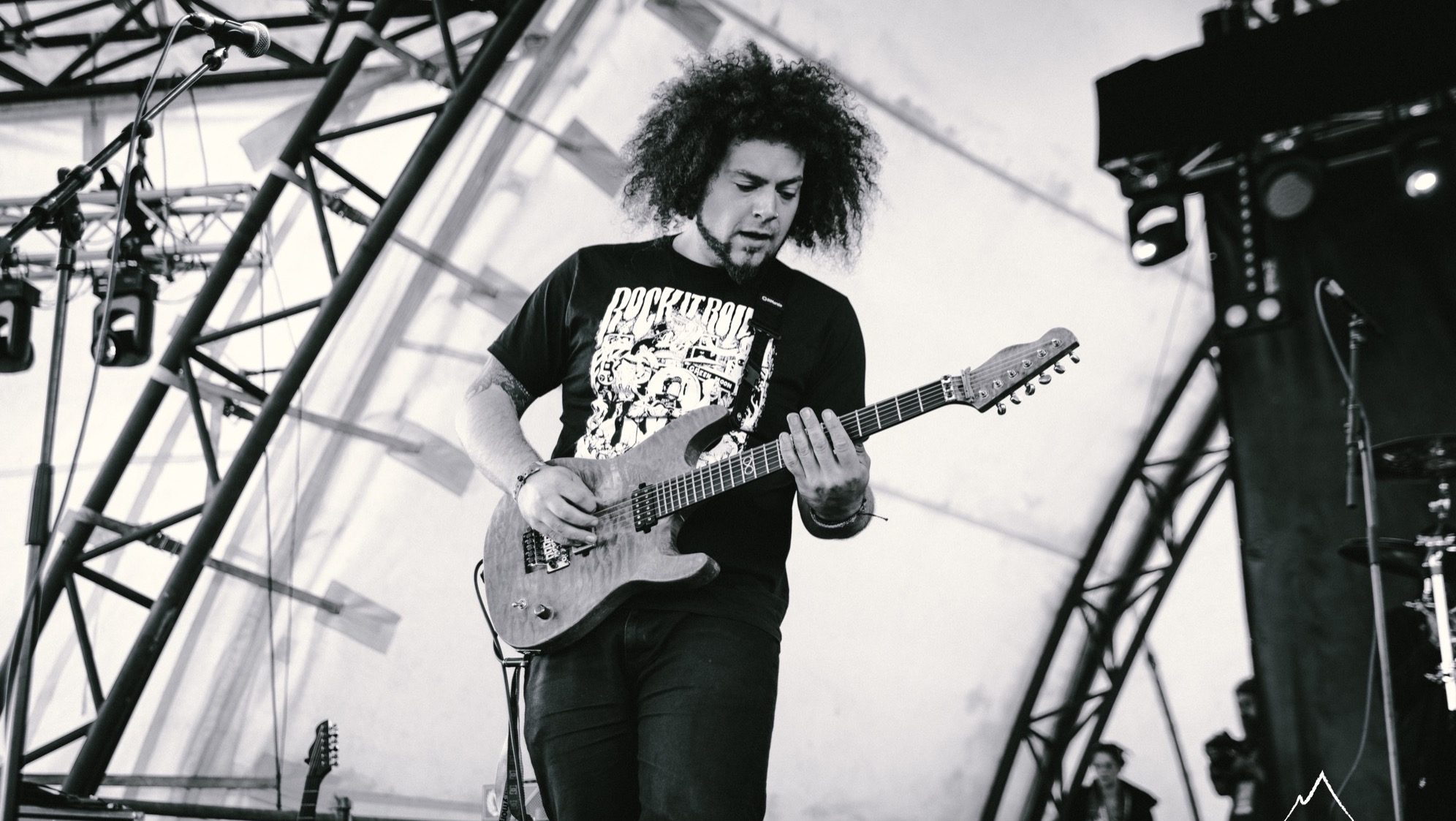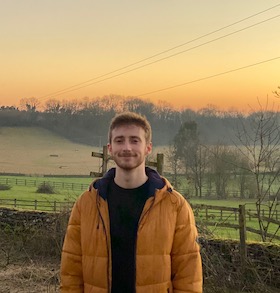Rabea Massaad: "All the opportunities I've had and the things I've achieved have come off the back of going into the world of YouTube"

Despite the bursting-at-the-seams nature of the guitar gear demo scene, a preliminary scroll through the internet's depository of videos will no doubt promptly throw up Rabea Massaad's name.
Massaad, who has amassed a huge following in the online guitar world, has made a name for himself not only by demystifying an entire catalog of effects pedals, electric guitars and more, but by showing he's more than capable of putting such devices into practice in an array of musical settings.
More recently, the accomplished axeman celebrated the post-pandemic grand opening of the live music world by embarking on his first-ever session experience – a gig that happened to be headlining England's Reading and Leeds Festival with rap royalty, Stormzy.
Cherry-picked for the job after impressing musical director Kojo Samuel with his quick-fire Instagram clips, Massaad's most recent musical escapade conquering one of the most hallowed stages in music is complemented by his own metal/prog/rock musings with Toska, Dorje, Frog Leap and The Totemist, among others.
Andertons alumni, baritone aficionado and Chapman Guitars signature artist, Massaad's journey is one that epitomizes the modern musician: an ever-expanding live portfolio propped up by a staunch social media presence.
We caught up with Massaad after his awe-inspiring Reading and Leeds Festival performance to discuss how he landed the job, the origins of his gear demoing days and his current jam sessions with Black Peaks' Liam Kearley and Joe Gosney, which he teases could be the beginnings of an all-new band.
Let's start by talking about your epic Reading and Leeds Festival appearance. How did you land the gig in the first place?
Get The Pick Newsletter
All the latest guitar news, interviews, lessons, reviews, deals and more, direct to your inbox!
"To be perfectly honest, it came through Instagram. It was completely out of the blue. According to [Chris] Bronski [Jablonski, creative director of Tawbox], they had been looking for a guitarist specifically for this type of show. When I asked them about it, I said, 'Do you know I do stuff on YouTube? I've been doing stuff on there for the last 10 years.' He had no idea.
"He said, 'I was just sifting through Instagram and your profile came up. I sent it over to Stormzy and we were like, yeah, this is the guy for the gig.' They spoke to their musical director Kojo Samuel, and he sent me a message on Instagram.
"The Instagram inbox isn't the easiest to sift through, so I actually didn't even see the message at first. Luckily, Kojo reached out to my friend Jack Duxbury, who had worked with him in the past, and said, 'Do you know this guy? We need to get hold of him.' So I got a message from Jack saying, 'Answer your phone!'"
What was the whole creative process like, in terms of conceiving the idea and taking it through to the finished product?
They wanted to do a rock-style intro to hark back to the early days of Leeds and Reading, when it was more heavy music-inspired
"Kojo said they wanted to do a rock-style intro to hark back to the early days of Leeds and Reading when it was more heavy music-inspired, with some guitar solos and some big riffs.
"The big riffs and chugs that I played more or less stayed the same throughout the process, but of course Kojo was like, 'Yeah, we'll have some stabs at the start to try and make it more dramatic.'
"It was really nice actually, because I was expecting the MD to be like, 'This is how it's going to be,' but it wasn't like that at all. He was really cool to work with, and he wanted to do a When Doves Cry-style intro, so that was quite fun to try and interpret."
A post shared by Rabea Massaad (@rabeaafro)
A photo posted by on
What do rehearsals look like for a gig on such a large scale?
"Rehearsals were literally just a couple of days. I got called at the end of July, and we were in for two days at the beginning of August, three days leading up to Leeds and Reading, and that was it.
"It was a quick turnaround. There wasn't much time, but it was all so tightly knit. It was insane to be a part of, to be honest."
It's a pretty intense first gig to return with after the pandemic. How did you prepare for it?
"I was obviously excited for a gig, and I really wanted to play one, but it couldn't have been further from the kind that I thought I'd be playing when I came back. It was so much more intense than I was anticipating. I thought I was going to be playing a gig either with Toska, Frog Leap, or just something that I was very accustomed to.
Reading and Leeds Festival was my first session gig ever and my first gig back in nearly 18 months, so it was a lot
"This was my first session gig ever and my first gig back in nearly 18 months, so it was a lot. For those three days between production rehearsals and the festival, I was like, 'Oh my god. I am really nervous.'
"I definitely ran everything at home a lot more. The best thing you can possibly do is just make sure you're sick of playing it so it's so far in your muscle memory that, no matter how intense it feels at the time, you can just crack on.
"It wasn't the crowd that was the issue. It was all the other variables on the stage, like the time-variable changes on the [Neural DSP] Quad Cortex. But I just hit that first note, and then it all came flooding back, and it was just like any other gig."

Has the experience made you want to explore the "session musician" avenue in future projects?
"I honestly feel like, in the capacity that the Stormzy gig happened – in the sense of being a guest in the production, rather than a session player in the band – that was enough.
"I don't really have any interest in necessarily being a session guitarist that goes touring with other bands. I just really enjoy what I'm doing with original material, with my own music, YouTube and everything else. It's all great.
"In the capacity of going out and doing a few shows like that, that would be wicked. If someone came through with something and said, 'Do you fancy dong this?' Then we'll see what happens. Trying to go on a three-month tour with an artist as part of a session band, I probably wouldn't do it."
Are there plans to collaborate with Stormzy in the future for any upcoming gigs?
"As far as I understand it was a one-off. And, to be fair, even if there was something, I wouldn't be allowed to say. I really wasn't allowed to say anything or share anything on social media.
"In fact, a couple of my mates were in the audience at Reading Festival and I saw one of them in the guest area afterwards. He was like, 'Honestly mate, I was stood there and I saw this guy and I thought, 'That kind of looks like Rabea.' Then the light came on and he was like, 'Fucking hell, that is Rabea!'
"It was certainly a blip in my everyday existence, in a good way. It was totally random compared to my everyday life."
Gear-wise, you can be seen playing your signature Chapman. How did you go about designing that particular guitar, and were you always going to play it for this gig?
"I was always going to play my signature guitar for a gig like that. In a lot of ways, when I'm playing in original bands and stuff – Frog Leap aside, because I have to use the [Line 6] Variax for that – I've always played my own guitars. They're tailored to what I'm doing. The newest one [ML3 BEA Pro] was always meant to be a lead-y kind of guitar, so it just fit. And it has my new Bare Knuckle in it. And to be honest, I would be doing Chapman dirty if I had gone on with something else.
"This latest iteration is way more refined than the last couple. The one before didn't have my Bare Knuckle in it or anything like that. And because we have a Standard Range, which is way more affordable, in my head I was like, 'I just want to make the thing I want the most.'
"It had to have the Bare Knuckle in it, the Schallers, all the bells and whistles of a guitar that I would really want to play. I wanted free rein to do whatever, and that's basically what I was allowed to do.
"On the aesthetic side, aside from wanting it to look cool, I never wanted it to look really signature-y. No disrespect to any guitarist that's got a signature guitar that is obviously theirs, but for me, I feel like... I would never put myself and my signature guitar up there with someone like Steve Vai and his Ibanez JEM.
I'd rather someone see my signature model for a cool-looking guitar and want to play it for that reason, rather than being like, 'I want it because that's Rabea's signature guitar'
"I'd rather a guy or a girl walk into a shop and see it for a cool-looking guitar and want to play it for that reason, rather than being like, 'I want it because that's Rabea's signature guitar.'"
You also used the Neural DSP Quad Cortex.
"The main reason for a gig like that is because you can't really be bringing big rigs and pedalboards and all that stuff. It needed to be something portable and when I was told what kind of gear I needed to bring, I knew immediately I was going to use that, because it's great.
"I captured my amps to use for the sounds, so what you heard was a capture of my [Victory] Kraken and Mezzabarba that I had blended together and used across the board. Everything was in the Neural DSP Quad Cortex. It just had to be as compact as possible. And aside from the fact it was portable and it sounded good, it also felt nice. It feels nice and amp-y.
"For me, where I wouldn't be able to have the usual rig – because everyone who plays guitar can appreciate the valve amp thing – which is quite common nowadays because that's just how it is with touring, it would make way more sense to create the same rig in the Quad Cortex."
This entire story stems from your background as a YouTuber and gear demo guy. How did you get into that side of things?
"To put it as short as possible, for me it was just about wanting to play and be the best guitarist I can be. Then I did the band thing and wanted to get signed and do all that. I was never interested in YouTube or gear or anything like that until I met Rob [Chapman] in 2011. Even then, I wasn't that into it. I had my three Boss pedals, my Washburn N4, and as far as I was concerned that was all I was going to use.
"When I moved in with Rob, he had loads of gear, so I just got more interested in it and messed around with more stuff. Then he suggested I set up a YouTube channel. He was already doing stuff on there and was experiencing how cool it is to do it. He was really determined to help me try and do the same thing.
All the opportunities I've had and the things I've achieved have come off the back of going into the world of YouTube
"Apart from wanting to be the best songwriter and player that I could be, all the opportunities I've had and the things I've achieved have come off the back of that and going into the world of YouTube."
What advice would you give people looking to build their own online presence?
"Nowadays, having an online presence is absolutely crucial. I feel like, as sad as it might sound, it's not possible without absolutely going to town on your socials. Not necessarily ramming it down people's throats, but setting yourself up on the platform and being consistent, finding your niche and finding the things that make you feel comfortable on there.
"Having a strategy – for me, my strategy has always been, 'Just crack on and stuff will happen' – is important, but consistency is the key. If you've got something to show to the world, then, ultimately, if they like it, it's going to work over time."
You do all of this while also having other projects – such as Dorje, Toska, Frog Leap and The Totemist – going on in the background. How are things with those groups after the pandemic?
"Dorje has been inactive for quite a long time, but as far as Frog Leap is concerned, it was just a case of stopping until it was over and then we've just carried on again. I mean, it's Leo [Moracchioli]'s thing, and he's on volume thirty-something, so there are hundreds and hundreds of covers that he's already done. It's just a case of learning them, putting your own spin on them, jamming them with the band and then going out on tour. That's great. Until Leo decides to stop that, that will continue.
"With Toska, sadly, I think the pandemic was the catalyst for something that we'd all been... It's not that we'd all been wanting to end it, but subconsciously there were a few things that were going on in the background. Ben [Minal] has kids, and Dave [Hollingworth] was doing a lot more on the design side of things with Chapman.
"Maybe at some point we'll continue in the studio, just jamming and writing, but I saw [the band splitting up] coming a way off."
What about your new project, The Totemist? How did you first team up with Liam Kearley from Black Peaks, and what does that project let you explore?
Going down the full-on prog road again would be fun, but I want to try something else now. With The Totemist, there is an element of that
"Well, Frog Leap is out-and-out metal, and I feel like going down the full-on prog road again like we did with Toska... It would be fun, but I want to try something else. I have done for quite a while now, and with The Totemist there is an element of that. It was all born out of Toska being inactive and Black Peaks for Liam [Kearley] being inactive during Covid.
"We skate together but we'd never actually jammed, so that was born out of frustration with the pandemic but also from being really good friends and our love for just jamming and writing riffs. It turned around so quick, because it was just so fun. I mixed it here in my studio, and we just released it. It felt great to do that."
What does the future look like for The Totemist, and do you have anything else in the pipeline?
"Liam and I are going to continue jamming, but also Joe [Gosney] from Black Peaks has been coming over from Austria and we've been writing riffs together. It's nothing right now, but we have an intention to turn it into something soon.
"Both Joe and I have never played in bands with two guitarists so that's been quite cool to work with. Even though most of our favorite bands have two guitarists – Karnivool, my favorite band ever – a lot of them do it to perfection.
"I feel like it's all going to fit in with a similar sound. The collective influence is bands like Gojira, Deftones, Mastodon, Karnivool, just to name a few. Those are the kind of bands we're all into and I feel like we can't help but sound a little similar. If anything comes of it, it will be a pretty fun band to listen to. Now we just need to find a singer, a bass player and the rest of it."

Matt is the GuitarWorld.com News Editor. He has a Masters in the guitar, a degree in history, and has spent the last 16 years playing everything from blues and jazz to indie and pop. When he’s not combining his passion for writing and music during his day job, Matt records for a number of UK-based bands and songwriters as a session musician.
“I was in a frenzy about it being trapped and burnt up. I knew I'd never be able to replace it”: After being pulled from the wreckage of a car crash, John Sykes ran back to his burning vehicle to save his beloved '76 Les Paul
“His songs are timeless, you can’t tell if they were written in the 1400s or now”: Michael Hurley, guitarist and singer/songwriter known as the ‘Godfather of freak folk,’ dies at 83









